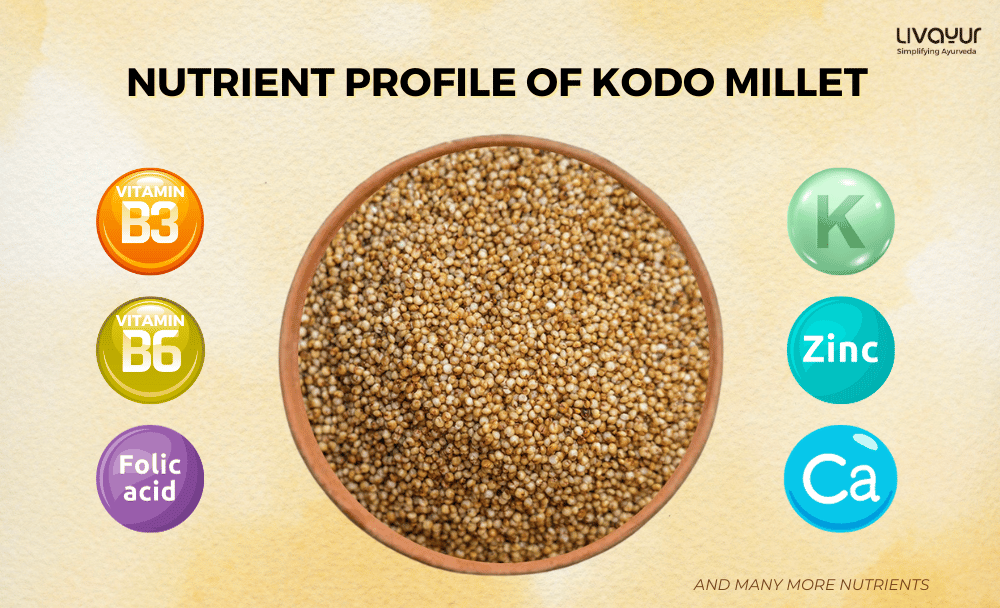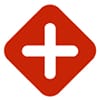
Are you a millet lover? If yes, then you’ll probably have some idea about Kodo millet, an ancient grain. Recently, there has been a growing interest in rediscovering ancient grains for their nutritional value and health benefits. Kodomillet, scientifically known as “Paspalum scrobiculatum,” is one such grain that has gained attention for its exceptional nutritional content, various health benefits, and traditional uses in Ayurveda. [1] Acharya Sushruta has mentioned Koradusha in managing Prameha as a Pathya Ahara. [3] Ayurveda mentions several Kodo millet uses.
This article delves into the Kodo millet nutrition profile, Kodo millet benefits, Ayurvedic applications, potential Kodo millet side effects, and several other aspects of Kodo millet.
Nutrition profile of Kodo millet
Kodo millet is a cereal crop that belongs to the Poaceae family. It has been cultivated for centuries in various parts of the world, especially in countries like India, Africa, and Southeast Asia. Kodo millet in English is known as Cow Grass, Rice Grass, and Ditch Millet. This millet is gluten-free, provides 353 Kcal energy per 100 gm of grain, and is rich in a range of essential nutrients, making it a valuable addition to a balanced diet.
The following table elaborates on the nutritional value of Kodo millet per 100 grams of grain.
| Nutrient | Quantity (100 gm) |
| Moisture | 11.6 gm |
| Protein | 10.6 gm |
| Fat | 4.2 gm |
| Fiber | 10.2 gm |
| Ash | 2.95 gm |
| Calorific value | 346 kcal |
| Carbohydrate | 59.2 gm |
| Minerals | 4.4 gm |
| Calcium | 27 mg |
| Phosphorus | 188 mg |
| Iron | 0.5 mg |
| Riboflavin | 0.09 mg |
| Niacin | 2.0 mg |
Kodo millet properties
Ayurveda mentions several health benefits of Kodo millet. Here are some key pointers about the properties and characteristics of Kodo millets:
1. Nutritional profile:
Kodo millet is rich in nutrients such as carbohydrates, fiber, and proteins. The grain contains essential minerals like calcium, iron, and phosphorus. It also has vital vitamins like niacin and riboflavin. Also, Kodo millet has a low glycemic index, making it a perfect choice for managing blood sugar levels. Thus, one of the varagu arisi benefits is its potential in managing diabetes.
2. Antioxidant properties:
Kodo millet contains antioxidants that help reduce oxidative stress in the body, potentially protecting cells from damage caused by free radicals. They have a high amount of antioxidants and phenolic compounds like vanillic acid, gallic acid, tannins, ferulic acid, etc.
3. Blood glucose regulation:
One of the many kodo millet health benefits is it aids in blood glucose regulation. Its low glycemic index contributes to better glycemic control.
4. Blood pressure regulation:
Some research indicates that consuming Kodo millet might positively impact blood pressure, contributing to lower blood pressure levels.
5. Anti-allergic properties:
Limited research indicates the presence of compounds in Kodo millet that may possess anti-allergic properties, though more extensive studies are required to establish this definitively.
6. Anticancer potential:
Some research indicates that certain compounds in Kodo millet might have the ability to inhibit abnormal cell growth. This anticancer property requires further investigation for conclusive evidence.
7. Lipid level regulation:
Some studies suggest that Kodo millet consumption may contribute to reducing abnormally high lipid levels, aiding in maintaining a healthy lipid profile.
8. Antibacterial properties:
Research also indicates that certain components within Kodo millet may possess antibacterial properties, though the extent and specific mechanisms require further investigation.
Kodo millet for health
1. Helps in diabetes management:
The complex carbohydrates in Kodo millet are digested slowly, leading to a gradual and slow rise in one’s blood sugar levels, which is beneficial for individuals with diabetes. It also decreases the likelihood of cataract diseases caused by diabetes. [1] According to Ayurveda, Kodava, or Kodo millet in Hindi, contains Madhura Kashaya rasa, Katu Vipaka, Sheeta Virya, Lekhana, and Shoshana properties which further lead to Kleda Shoshana or the absorption of Kleda and controls Madhumeha or Diabetes. [3]
2. Supports heart health:
The presence of antioxidants and, thus, a higher amount of free radical scavenging activity adds to the Kodo millet benefits as it can keep your heart healthy by minimizing the risk of cardiovascular diseases. [1]
3. Is gluten-free:
Kodo millet is a nutritious alternative for those who are gluten-sensitive or suffering from celiac disease. Therefore, Kodo millet provides essential nutrients without triggering adverse reactions. [1]
4. Is anti-cancerous:
Yet another of the several Kodo millet health benefits include its property of having abundant sources of phenolic acids, tannins, and phytates, which are considered to have properties as anti-nutrients that, in turn, are associated with a reduction in the risk of colon and breast cancer. Within millets, certain phenolic compounds have demonstrated efficacy in preventing the onset of cancerous growth and stopping the in vitro proliferation of cancer cells. [1]
5. Delays aging
Aging often stems from non-enzymatic glycosylation—a chemical reaction between protein amino groups and sugar aldehyde reduction groups. Millets like Kodo millet boast antioxidants and phenolics like phytates, phenols, and tannins, which have the power to offer crucial antioxidant benefits in health, aging, and managing metabolic syndrome. These compounds hold promise for mitigating the effects of glycosylation, contributing to overall well-being and metabolic health. [6]
6. Benefits the kidney
Kodo millet aids kidney health with its low potassium, high fiber, and reduced uric acid formation. Its antioxidants and flavonoids facilitate blood purification, curbing gall bladder and kidney stone formation, making it beneficial for those with kidney disorders. [7]
7. Aids in weight loss
There have been numerous studies corroborating Kodo millet benefits for weight loss. Kodo millets, rich in polyphenols, combat obesity by curbing weight gain, limiting fat storage in adipose tissue, and combating inflammation. Its significantly low Glycemic Index and high content of fiber further aid weight management, making it an advantageous choice for weight control and overall health. [8]
8. Supports digestive health
The abundant fiber in Kodo millets supports the prevention of conditions like constipation, gas, bloating, and cramps by promoting healthy digestion. It fosters the growth of beneficial gut bacteria crucial for optimal digestive function, aiding overall digestive health and comfort. [7]
9. Has healing properties
Kodo millets’ antioxidants and polyphenols combat free radicals, supporting cellular repair processes. Traditionally, applying a paste of Kodo millet flour on cuts and wounds harnesses its healing properties, aiding in their recovery. [9]
10. Addresses malnutrition issues
Malnutrition, spanning energy or nutrient imbalances, includes undernutrition, micronutrient deficiencies, and overweight issues. Kodo millets, packed with carbohydrates, proteins, fibers, vitamins, minerals, antioxidants, and phenolic compounds, may assist in managing micronutrient-related malnutrition. [10]
Studies have also shown that Kodo millets serve as excellent sources of folic acid, making them highly adaptable for inclusion in diets, particularly beneficial for women and children. [11]
Ayurvedic uses of Kodo millet
Ayurveda lists numerous Kodo millet uses. The Guru and Ruksha Gunas of Kodo millet accord it a variety of therapeutic uses that deal with:
Obesity, Raktapitta, Pittaj Kasa,Visha, Urustambha, Trishna, Jalodara, Kustha Stanyadosa, Jalodar. [2]
Kodo millet holds a significant place in Ayurveda, the ancient Indian system of medicine. According to Ayurvedic principles, Kodo millet is considered Tridoshic, meaning it balances all three Doshas with a Vayukarak effect that increases the Vata Dosha and Pitta Kaphapaah effect that balances the Pitta and Kapha Doshas. [4]
Some traditional Ayurvedic uses of Kodo millet include:
- Kodo millet is Laghu in nature, and is, therefore, easily digestible.
- Kodo millet has Vishajith properties, which help the millet destroy the adverse impacts of poison.
- The Lekhana attributes of this millet can eliminate excess fat from your body.
- Kodo millet can balance the Kapha and Pitta Dosha.
How to use Kodo millet
Kodo millet nutrition can be harnessed in a variety of ways. Some of the ways for kodo millet uses are as follows:
1. Kodo millet salad
Cook and fluff Kodo millet, then combine with corn, carrot, coconut, pomegranate, boiled green gram, lemon juice, and salt. Temper mustard seeds, urad dal, green chilies, curry leaves, and hing in oil, then mix into the salad gently for added flavor.
2. Kodo millet health drink
Rinse Kodo millet and simmer in a pan with water and turmeric for 20-30 minutes till soft, stirring occasionally. Blend coconut, cumin, and onion into a paste, add to the cooked millet, and season with salt for a flavorful Kodo millet kanji.
3. Kodo millet pulao or khichdi
Sauté veggies and spices, add washed Kodo millet, and cook with water or broth for a flavorful pulao; for khichdi, cook Kodo millet with dal, veggies, and spices, finishing with a tempering of mustard seeds, cumin, and curry leaves.
4. Kodo millet flour
Combine Kodo millet flour with wheat flour for chapatis or rotis; blend it with spices and water to make a batter for savory pancakes or dosas.
5. Kodo millet breakfast cereal
Simmer Kodo millet with milk or water, sweeten it with honey or jaggery, and top it with fruits and nuts for a nutritious breakfast cereal; alternatively, cook Kodo millet with spices, vegetables, and broth for a savory breakfast porridge.
6. Kodo millet noodles
Boil Kodo millet noodles until al dente, toss with stir-fried veggies, protein of choice, and a flavorful sauce for a wholesome noodle dish; alternatively, use Kodo millet noodles in soups or salads for added texture and nutrition.
Kodo millet is also often used to prepare various other dishes like Kodo millet halwa, pappad, thatuvadai, muruku, kolukattai, and much more. [4]
Side effects and precautions
While Kodo millet offers numerous health benefits, there are a few considerations to keep in mind. Read about the Kodo millets side effects below:
- Consumption of contaminated Kodo millets can lead to Kodo poisoning, which is characterized by elevated liver enzymes and liver toxicity. The clinical symptoms of this poisoning encompass vomiting, nausea, and unconsciousness, among others.
- Kodo millets contain goitrogens that disrupt thyroid hormones and can cause an enlarged thyroid gland (goiter).
- Apart from nutritional components, Kodo millets contain anti-nutrients like phytic acid and polyphenols, which diminish nutrient availability. Soaking Kodo millets before use is advised for reducing anti-nutrient levels.
- Due to Kodo millets’ potential to lower blood glucose, concurrent use with anti-diabetic medications should be avoided to prevent excessive blood glucose reduction.
- As Kodo millet lowers cholesterol, combining them with cholesterol-reducing drugs such as statins is not recommended, as this interaction might yield undesired effects.
- Seeking guidance from an Ayurvedic physician regarding potential interactions between Kodo millets and other drugs is crucial. Adhering to their prescription is essential, considering your health status and concurrent medication use. [5]
FAQs
1. Is it important to soak Kodo millets before using them?
Yes, Kodo millets harbor anti-nutrients such as phytic acid, polyphenols, and similar compounds that diminish the accessibility of essential nutrients. Employing techniques like soaking aids in diminishing the presence of these anti-nutrients. Thus, it is recommended to soak Kodo millet before use.
2. Can Kodo millets be used for weight loss/management?
Yes, it is low in fat content and high in protein and fibers; it increases satiety and reduces overeating, and thus can help in weight loss.
3. Can Varagu or Kodo millets in Tamil be consumed daily?
Incorporating millet into your daily diet can offer numerous health advantages. It aids postmenopausal women in combating heart conditions, and it may contribute to regulating elevated blood pressure and cholesterol levels. Individuals dealing with gallstones might find it beneficial due to its fiber content.
4. What are the various other names of Kodo millet?
Kodo millet, known by various names in different regions and languages, is referred to as “rice grass,” “ditch millet,” or “cow grass” in English. In Tamil and Malayalam, it is referred to as “varugu,” in Sanskrit as Kodrava, Kodon in Hindi, Harka in Kannada, Arikelu or Arika in Telugu, Kodra in Marathi, Gujarati, and Punjabi, and as Kaon Dana in Bengali.
5. Is it okay to consume Kodo millet regularly?
Yes, you can consume Kodo millet daily. However, Kodo millets do contain anti-nutrients such as phytic acid and polyphenols that can hinder nutrient absorption. Employing processing techniques like soaking can significantly decrease the levels of these anti-nutrients, enhancing the availability of nutrients for absorption and making it more suitable for daily consumption.
6. Are Kodo millet side effects similar to Finger millet side effects?
All types of millet are healthy. But even millets have potential side effects. Recently, one type of millet; i.e., Finger millet or Ragi is receiving all the attention due to its several health benefits. But, Finger millet like Kodo millet has side effects. One of the major Finger millet side effects is that it may lead to Kidney stones by heightening the level of Oxalic acid in the body. This is, however, not a Kodo millet side effect. So, Kodo millet side effects and Finger millet side effects are not the same.
7. Who should avoid Kodo millet?
Kodo millets should not be consumed by those who are constipated as this could make the condition worse. Ensure that any impurities are removed by cleaning it thoroughly. To ensure optimal nutrient absorption and digestion, soak Kodo millets for at least two to three hours before cooking.
8. Should kodo millets be soaked before use?
Kodo millet contains anti-nutrients such as polyphenols and phytic acid, which reduce the availability of essential nutritional components. Soaking them in water for 30 minutes before cooking is one of the simplest ways to minimize the anti-nutrients.
Conclusion
Kodo millet is a nutritionally rich ancient grain that has many health benefits and has been valued for its traditional uses in Ayurveda. With its high fiber content, essential nutrients, and potential to support various aspects of health, Kodo millet presents itself as a valuable addition to a balanced diet.
Disclaimer:
This article is written from a health and wellness perspective and is not medical advice. Kindly seek the help of a certified medical practitioner before initiating any treatment.
References:
- Nutritional, Functional Role of Kodo Millet and its Processing: A Review
- Millets: The Indigenous Food Grains
- Appraisal of Anti Hyperglycemic effect of Kodo millet (Paspalum scrobiculatum) – A Review
- Kodo Millet Uses, Qualities, Research, Recipes, Remedies
- Kodo Millets: Uses, Benefits, Side effects, and More By Dr. Rajeev Singh
- Nutritional, Functional Role of Kodo Millet and its Processing: A Review
- Nilamadana, new fungal fermented cereal based food
- Kodo millet whole grain and bran supplementation prevents high-fat diet induced derangements in a lipid profile, inflammatory status, and gut bacteria in mice
- Welcome to NIScPR Online Periodicals Repository
- Biofortification in Millets: A Sustainable Approach for Nutritional Security
- Millets: Malnutrition and Nutrition Security


















